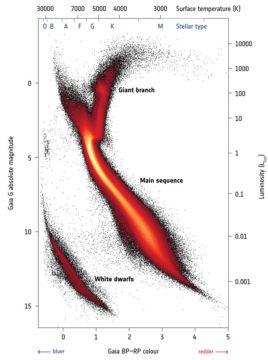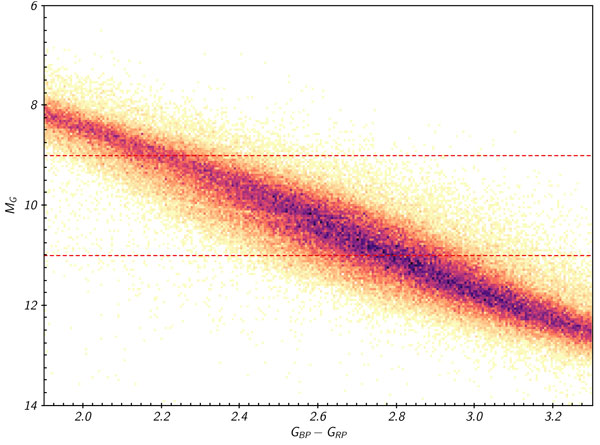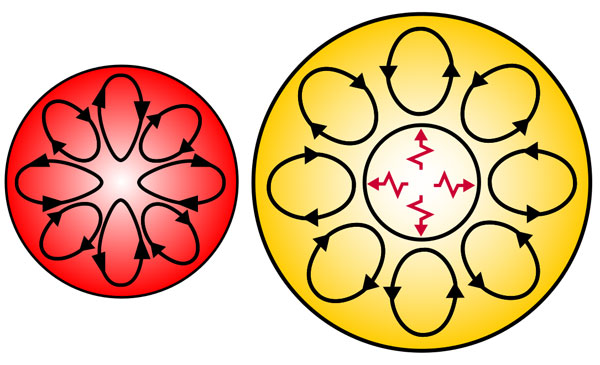Using "Big Data" collected by the Gaia satellite and released earlier this year, astronomers have discovered a hiccup in stellar luminosities that may point to a new understanding of stellar structure.

Gaia DPAC / Carine Babusiaux (Grenoble Institute of Planetology and Astrophysics, Observatory of Paris)
If you’ve ever taken Astronomy 101, you might remember the Hertzsprung-Russell diagram (or you might still have it tattooed on your arm). The HR diagram, as it’s commonly known, is basically a one-stop stellar shop: Based on a star’s color and brightness, the diagram reveals its size and temperature, what stage of evolution it’s in, its internal structure, and much more. First put down on paper in the 1900s, this simple diagram is still revealing stellar secrets more than a century later.
After the release of the Gaia satellite’s second dataset, with high-precision distance measurements to an astonishing 1.7 billion stars, astronomers in the Gaia collaboration immediately put together multiple versions of the HR diagram. The sheer mass of stars paints a vivid, “Big Data” picture of stellar evolution. Stars spend most of their lives fusing hydrogen into helium in the so-called main sequence before aging onto the red giant branches, where more massive stars eventually go boom, or the white dwarf sequence, where less massive stars gradually fade away into obscurity.
Now, a team of astronomers led by Wei-Chun Jao (Georgia State University) has announced the discovery of a narrow but distinctive gap in the diagram in the July 1st Astrophysical Journal Letters (free preprint available here). The gap is so distinct that it might look like an instrumental artifact, but Jao and colleagues see the same gap in stars with infrared data from 2MASS, so it's definitely real. While most of the main sequence transitions smoothly from one type of star to the next, there’s a tiny hiccup in the transition among the coolest, faintest red dwarfs. Known as M stars, these are the smallest, lowest-luminosity stars in the hydrogen-fusing main sequence (the “Me”s from Oh Be a Fine Guy/Gal Kiss Me).

Jao et al. The Astrophysical Journal, 1 July 2018
The very smallest M stars are unique in that they have a fully convective interior, meaning their whole insides are a boiling mass of plasma. The very largest M stars are more like the Sun, where a convective envelope surrounds a radiative zone, a denser area where boiling motions are suppressed. Energy travels more slowly in this compressed interior — it can take anywhere from a few thousand to a few million years for a photon to escape from inside the Sun.

Wikimedia Commons
The transition between these two interior structures occurs when red dwarf stars have about a third of the Sun’s mass. The gap that Jao and colleagues found is at exactly that mass. The question is, why? After all, most theoretical models of stellar structure show a smooth transition here — in other words, there ought to be just as many stars with a fully convective structure and 0.34 solar masses as there are stars with a radiative core and 0.35 solar masses.
Shortly after Jao’s study was published in the July 1st Astrophysical Journal, another paper led by James MacDonald and John Gizis (both at University of Delaware) appeared on the astronomy preprint archive. The gap, these authors argue, is actually a feature of existing theory. It’s just that finding it requires examining a very narrow mass range. Gaia showed them where to look.
The gap, they explain, comes about because interior structure affects the efficiency of the stars’ power source. The boiling motions in the cores of smaller, lower-mass stars help mix intermediate products of fusion reactions, allowing the star to fuse hydrogen more efficiently and steadily increase its luminosity. More massive red dwarfs are less efficient fusion reactors and stay relatively constant in luminosity. As one structure replaces the other, the difference creates a dearth of stars of a particular brightness.
Still, questions remain. The incredible detail in Gaia data shows that a very few stars do appear in the gap — why are they there? Also, the gap appears to be wider for stars less polluted by heavier elements — what is it about these “purer” stars that affects their stellar structure? A century after astronomers first began understanding stars in a systematic way, stars continue to prove themselves more complicated than we knew.
 3
3









Comments
Sciencesprrings
August 6, 2018 at 3:28 pm
No link to science paper in The Astrophysical Journal
You must be logged in to post a comment.
Monica YoungPost Author
August 6, 2018 at 3:48 pm
Link added, thanks!
You must be logged in to post a comment.
Lou
August 7, 2018 at 8:35 am
Interestingly, a press release from Georgia State University says: "it appears the gap is caused by a slight shrinking in size if a star is convective all the way through." Could it be both shrinking and mixing at play?
You must be logged in to post a comment.
You must be logged in to post a comment.